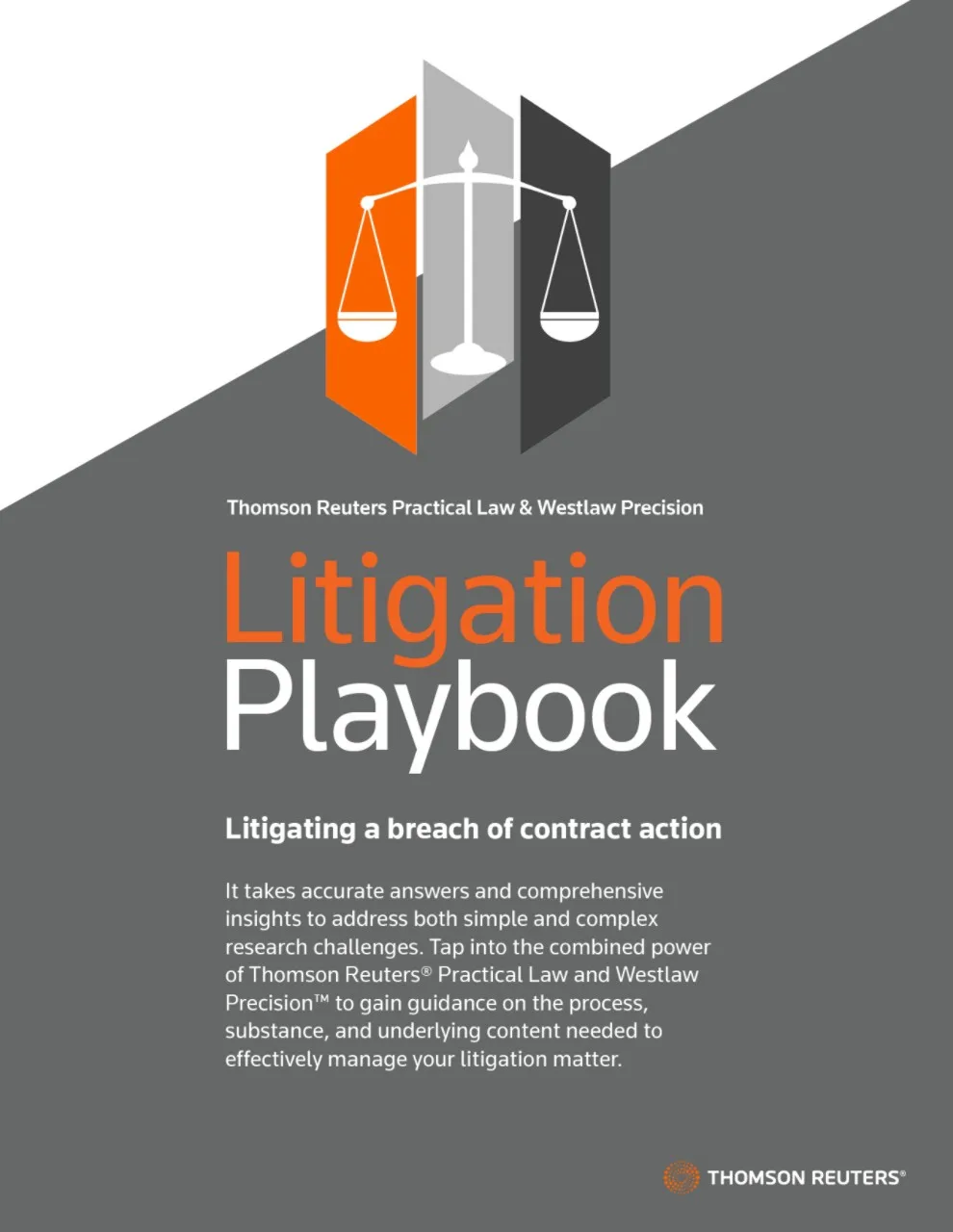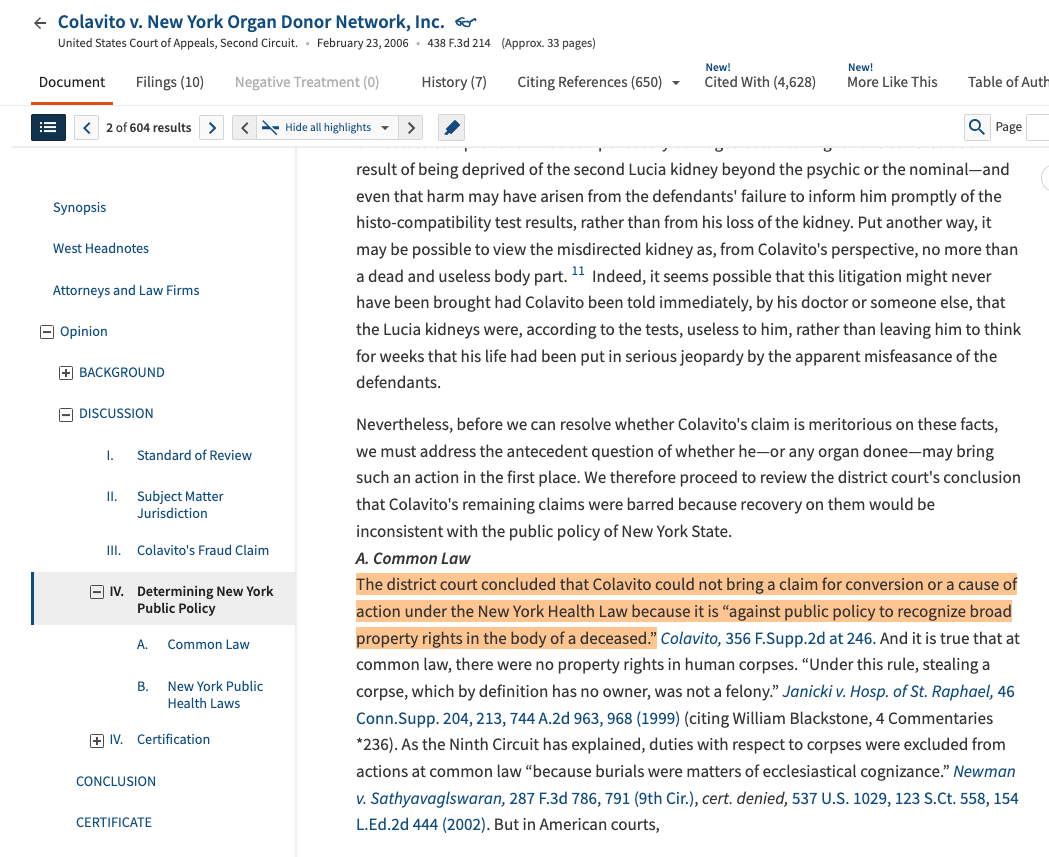Overview, step-by-step guide, and other resources.
Legal terms · claim · cause of action
Highlights
- The elements of a cause of action are the specific components that must be established to prove a legal claim.
- Identifying a cause of action involves a multi-step process, including establishing a legal right, a corresponding duty, a breach of that duty, and resulting damages.
- The discovery rule can delay the start of the statute of limitations until the plaintiff discovers or should have discovered the injury.
This how-to guide serves as a general reference for both novices and any seasoned lawyers looking for a thorough review of the topic before proceeding to more in-depth analysis and research.
Jump to ↓
| What is a cause of action? |
| Cause of action examples |
| Discovery rule |
| How to identify the cause of action |
| Cause of action by state and more resources |
What is cause of action?
Cause of action is the legal claim — a claim that sometimes goes unstated — that allows a party to seek judicial relief.
This gives the legal right to seek a remedy because of the act or omission, failure to perform duty, or breach of obligation of the defendant towards the plaintiff. A trial can begin only after a cause of action arises.
Black’s Law Dictionary defines CoA as “a group of operative facts giving rise to one or more bases for suing; a factual situation that entitles one person to obtain a remedy in court from another person.”
Providing a uniform and precise definition of the cause of action is impossible. According to Edwin. E. Bryant, cause of action may be defined as a situation or state of facts entitling a party to maintain an action before a judicial tribunal.
In Coke v. Gill (1873) LR 8 CP 107, the court of Common Pleas elaborated on the meaning of a cause of action for getting the judgment in favor, it emphasized:
- A cause of action includes all essential facts that the plaintiff must establish to demonstrate their legal right to relief.
- If the facts are disputed, the plaintiff bears the burden of proving those facts in court to succeed in the claim.
The elements of cause of action
Elements of cause of action are specific components or requirements that must be established to prove a legal claim. The essential elements for constituting a specific cause of action are covered by the following:
- Statutes — A statute is a legislative enactment that describes the rights and duties of the stakeholders covered under it. If an act or omission does not constitute a valid right or does not impose any liability, the same cannot be considered a valid cause of action.
- Judicial precedent — Sometimes, the language of a statute or regulation cannot properly determine if something is a valid cause of action. In such times, the judicial precedents serve as a guide to what constitutes a valid cause of action.
- The Constitution — The supreme authority of the Constitution is the last source to determine whether a certain action or omission can constitute a valid cause of action.
However, the elements depend on the type of litigation (e.g., key elements that arise in commercial litigation). In federal litigation, CoA is only recognized if a right enshrined in the Constitution is violated, and affirmative action can be initiated before the federal court.

Playbook by Practical Law
Litigating a breach of contract action: The answers you need and how to proceed when litigating a matter
Download free playbook ↗What are the kinds of cause of action?
The main kinds of causes of action include breach of contract, negligence, implied causes, defamation, torts, fraud, and conversion. Each one has specific elements that must be established for the claim to proceed.
1. Breach of contract cause of action:
To establish a claim for breach of the contract, the following elements are to be established:
- There cannot be a breach without the existence of a valid and legally binding contract between the parties, whether written or oral. The contract must possess all essential elements such as an offer, acceptance, legal consideration, and, most importantly, the intent of the parties to create a contract.
- The plaintiff must establish that the defendant has committed a breach of their contractual duties.
- The plaintiff must demonstrate that they suffered loss or harm due to the defendant’s breach.
Imagine being admitted to a federal court pro hac vice to represent a long-time client in a contract dispute. You’ve agreed to take the case, even though it’s outside your usual jurisdiction. Your deadlines are approaching, and you need to quickly get a handle on unfamiliar law and procedure.
Download a free litigation playbook to get clear answers, step-by-step guidance, and practical notes and tools for defending breach of contract claims in unfamiliar courts and jurisdictions.
2. Statutory cause of action:
For a statutory cause of action, the primary question to be answered is whether a duty or prohibition exists for certain actions in the particular statute. After this, the following are to be established:
- The plaintiff must prove that the defendant owed a statutory duty towards him.
- The defendant must have breached this duty.
- The plaintiff must have suffered harm or injury due to the defendant’s statutory violation, and the damage suffered must be directly linked to the breach of duty.
3. Implied Cause of Action
An implied cause of action arises when there is no direct cause of action in a statute or legislation, and a court still recognizes a legal remedy. This recognition by the court gives rise to an implied cause of action, even though no legal remedy is explicitly provided.
The US Supreme Court’s test in Cort v. Ash, 422 US 66 (1975) laid the groundwork by providing four factors to determine when a statute implies a cause of action.
The factors are:
- Whether the plaintiff is part of the class of persons “for whose especial benefit” the statute was enacted;
- Whether the legislative history, explicit or implicit, suggests that Congress intended to create or deny a legal remedy/cause of action;
- Whether granting an implied cause of action is consistent with the underlying purpose of the legislative scheme, and
- Whether the issue would be traditionally relegated to state law, and is the concern of the states.
Constitutional implied cause of action
Constitutional CoAs are those when the plaintiff can apply for a breach, not of a statutory right, but of a constitutional violation.
The difference between the statutory and constitutional CoA is that in constitutional implied CoAs, there is no specific legislation or statute under which the judiciary implies that the plaintiff can file for breach and claim damages.
Statutory implied cause of action
While in statutory express causes of action, there is a clear right to file for a breach provided in the statute itself, a statutory implied cause of action is when the court has to interpret the structure and purpose of the statute.
4. Tort-related cause of action:
Fraudulent misrepresentation:
To give rise to a CoA, it must be demonstrated that:
- The defendant made a false statement or misrepresented a significant fact in the agreement.
- The defendant had the knowledge that the statement he was making was false and would lead to misrepresentation.
- The plaintiff has relied on the misrepresentation, assuming it is true, and has acted accordingly.
Conversion:
The plaintiff must prove that:
- He had a right over the property.
- This right was valid at the time when the conversion happened.
- The defendant intentionally and wrongfully took possession, or interfered with the concerned property without legal justification.
- He was deprived of the use, possession, or control of the property and suffered harm or loss due to the defendant’s wrongful act.
Negligence:
- The defendant owed the plaintiff a duty of care.
- The defendant breached or violated that duty of care by failing to act reasonably.
- The harm caused to the plaintiff must be by the defendant’s breach or a foreseeable consequence of the defendant’s breach of duty
- The plaintiff must have suffered actual harm or injury
Defamation:
- There must be a false statement made about the plaintiff, either spoken or written.
- The false statement must be made before someone else
- The false statement caused harm to the reputation in the third person’s eyes, or affected the emotional well-being of the plaintiff
5. Precedent cause of action
In the precedent cause of action, courts rely on previously decided cases to determine outcomes in current cases with similar facts or legal issues.
The following elements are key for them:
- The cause of action arose based on a doctrine established by a prior court decision
- The facts must be similar to the precedent case
- The precedent must come from a court whose decisions are binding
6. Equity-related cause of action
An example of equity-related CoA is unjust enrichment. This doctrine is based on mistaken payment, and the plaintiff can recover the amount equal to the advantages and services which he mistakenly provided to the defendant.
How does the discovery rule affect the accrual of a cause of action?
Under the statute of limitations, there is a specified duration of time for which the plaintiff can pursue a cause of action. What would happen if the cause of action is discovered at a later date?
Under the discovery rule, the limitations begin to run only after the plaintiff discovers or, through reasonable diligence, should have discovered the cause of action. This is applicable where the harm or wrongful act may not be immediately visible or known to the plaintiff.
The Discovery rule can be applied when the following elements are present:
- The plaintiff must be unaware of the act done by the defendant that caused him harm.
- After that, the plaintiff must discover or should reasonably be aware of the wrongful act or breach that caused harm.
- The plaintiff must discover the injury or damage, even if the harm is not immediately apparent. The discovery of the injury triggers the accrual of the cause of action.
How do you identify the cause of action?
To identify the CoA and institute a lawsuit, a plaintiff must prove all the elements of CoA, including wrongful action such as threats. However, wrongful action alone does not trigger a CoA – It is the existence of the injury, damage, or loss that happened due to that wrongful action.
In the United States, CoA is defined from the standpoint of the rights of plaintiffs and duties of defendants, with the breach of duty that resulted in loss and damage.
The following 6-step process gives attorneys confidence to specify CoA for their particular case.
1 – Existence of a legal possessory right in the plaintiff over the matter
The possessory rights mean that the plaintiff’s legal right exists and that the defendant’s act affects that right.
For instance:
- A gives B $100 for 2 months as debt.
- A has the right to bring suit against B if he does not pay after the lapse of time.
- Plaintiff A has the possessory right to be the actual owner of the money, creating his legal right and legal obligation on defendant B for payment within the proper time limit.
Case example: Colavito v New York Organ Donor Network, Inc, 8 NY3d 43 [2006]
The court reasoned that for the cause of action to arise in instances of conversion, the plaintiff’s possessory right or legal ownership interest must exist, and the defendant must have exercised dominion over the property or interfered with it, in derogation of the plaintiff’s rights.

2 – Corresponding legal duty in the defendant toward the plaintiff
There are several ways to determine whether the defendant had a duty to act:
- Creation of Risk: The defendant engaged in the creation of the risk, resulting in the plaintiff’s harm.
- Voluntary undertaking: The defendant volunteered to protect the plaintiff from harm.
- Knowledge: The defendant knows/should know that his conduct will harm the plaintiff.
- Business/voluntary relationships;
- Business owner and customer;
- Innkeeper and guest;
- Land possessor who opens her land to the public;
- A person who voluntarily takes custody of another person.
Case example: Solomon v. Bates 118 N.C. 311
In this case, the theory involves directors who are trustees for creditors and individually owe a legal duty to them. The directors were wrong in acting in a fraudulent, negligent, and mismanaged manner, affecting the creditors’ rights.
Case example: Purcell vs R.R 108 N.C 414
The court gave the verdict that the failure to discharge the duty required by the laws was a wrong caused by the defendant’s negligence, tort, and is properly united through tort by fraud and deceit forming part of the complaint.
3 – Wrong or violation of the plaintiff’s right, or breach of duty on the part of the defendant
A cause of action arises wherever there is proof that there was the existence of a duty towards the plaintiff by the defendant in which he failed resulting in a breach. The Wrongful Act or Omission forms part of the action that leads to affecting the right of the plaintiff.
For instance:
- A buys a horse from B.
- Later, he came to know that the horse is suffering from a life-threatening disease.
- As a result, B’s Non-Disclosure of information is part of the Wrongful Act with his clear intention to commit fraud against A.
- Here, A has full rights to bring legal action against B.
When the defendant intentionally interferes with the rights of the plaintiff they lay the foundation for the lawsuit with the cause of action.
Case example: Delano v. Case, 17 Ill. App. 531
In this case, the defendant committed a wrongful act on the ground of negligence. The court ruled that the purpose of the cause of action could exist where there has been a liability in the right of the corporation to be enforced.
4 – Concurrence of right, duty, and wrong
A right is an interest protected by the law or the state, and it’s the duty that mandates the protection of the right. But when the protection is infringed by a failure to follow the duty, it gives rise to the wrong committed and hence, to a cause of action.
5 – Damage
Damages can be defined as the injury caused or loss incurred by the plaintiff due to the failure of the defendant, and damages can be remedied by issuing a cause of action claiming damages.
Case example: Marzetti v. Williams (1830) 1 B & Ad 41
This case stated that every contract implies a duty to be performed by the parties, and in the event of breach, a cause of action arises against the party at fault, mandating the use of the maxim, Ubi jus ibi remedium — where there is a right, there is a remedy.
6 – Concurrence of wrong and damage
The maxims damnum sine injuria and injuria sine damnum are elaborative of the relationship between the wrong and damage.
- Damnum sine Injuria refers to damages without injury or damages where there is no infringement of any legal right in spite of the loss which might have been incurred.
- Injuria sine damno refers to infringement of legal right without causing any harm, loss, or damage to the plaintiff.
Whenever any legal right is infringed, the one who suffers can bring a cause of action against the one who infringed. Therefore, damages are the result of the cause of action through an actionable wrong.
Case example: Clark v. McClurg, 215 Cal 279
To establish that there was a breach of duty, the plaintiff must not only prove the existence of an actionable wrong but also damages thereof. It was emphasized that the concurrence of actionable wrong and damages is important for the cause of action to be advanced.
Case example: Mogul Steamship Co Ltd v McGregor, Gow & Co [1892] AC 25
This case established that immoral acts done lawfully led to no legal injury, hence no damages to be claimed by the plaintiff, and no point of the cause of action.
Last thoughts and resources for the legal researcher
Although this guide is limited in scope and purpose, it’s clear that your own duty as a lawyer is to be well-versed with the facts of a case and to competently analyze similar cases where possible.
This demands significant time and effort in both research and analysis, and understandably so. Yet the energy spent in gathering pertinent definitions and requirements don’t need to be so cumbersome.
The steps laid out above to specify causes of action serve only as basic principles so you can confidently proceed to the next phase of thorough analysis and file a lawsuit.
State-specific cause of action research resources
Do you need to perform further research on cause of action updates in a certain state?
Use the curated content below featuring practices notes, templates, toolkits, and guides from Practical Law.
Practical Law’s resources are written and maintained by over 650 dedicated full-time attorney-editors globally. They’re highly qualified, having practiced at the world’s leading law firms, corporate law departments, and government agencies.
For example, standard clauses provide model language for counsel to use in a certain state district or county court petition or federal complaint to plead various claims under state law. Counsel can use these standard clauses in a state petition or complaint properly formatted for the relevant court and tailored to the facts and circumstances of the case.
National/Federal cause of action resources
- All related content resources (National)
- Commercial Litigation: Causes of Action Checklist
- Class Action Toolkit: Causes of Action
- Voidable Transactions: Insider Cause of Action
- Voidable Transactions: Intentional Cause of Action
- ITC Section 337 Non-Patent Investigations: Overview
- All related content resources (AL)
- Trademark Laws: Alabama
- Statutes of Limitations: Alabama
- Local Bankruptcy Rules: Alabama (M.D. Ala.)
- All related content resources (AZ)
- Statutes of Limitations: Arizona
- Trademark Laws: Arizona
- Commencing an Action: Arizona
- All related content resources (AK)
- Statutes of Limitations: Arkansas
- Trademark Laws: Arkansas
- Commencing an Action: Arkansas
- All related content resources (CA)
- Commercial Litigation: Causes of Action Checklist (CA)
- Quiet Title Cause of Action (CA)
- Inverse Condemnation: Physical Taking Cause of Action (CA)
- Inverse Condemnation: Regulatory Taking Cause of Action (CA)
- Inverse Condemnation: Unconstitutional Conditions Taking Cause of Action (CA)
- Promissory Fraud Cause of Action (CA)
- Breach of Purchase and Sale Agreement by Buyer Cause of Action (CA)
- Breach of Purchase and Sale Agreement by Seller Cause of Action (CA)
- Trespass Cause of Action (CA)
- Fraudulent Concealment Cause of Action (CA)
- Specific Performance Cause of Action (CA)
- Specific Performance of Purchase and Sale Agreement Cause of Action (CA)
- All related content resources (CT)
- Statutes of Limitations: Connecticut
- Trademark Laws: Connecticut
- Commencing an Action: Connecticut
- All related content resources (DE)
- Breach of Fiduciary Duty: Cause of Action (DE)
- Cause of Action for Breach of Fiduciary Duty Seeking an Accounting Relating to an LLC (DE)
- Cause of Action for Breach of Fiduciary Duty Seeking an Accounting Relating to a Private Corporation (DE)
- Cause of Action for Books and Records of a Corporation (DE)
- Shareholder Derivative Complaint: Delaware Court of Chancery
- Cause of Action for Books and Records of an LLC (DE)
- Fiduciary Duties of Directors of Financially Troubled Corporations
- Trademark Laws: Delaware
- Merger Agreement (All-Cash, Pro-Buyer)
- Merger Agreement (Private Company, Pro-Buyer)
- All related content resources (DC)
- Statutes of Limitations: District of Columbia
- Trademark Laws: District of Columbia
- Commencing an Action: District of Columbia
- All related content resources (FL)
- Commercial Litigation: Causes of Action Checklist (FL)
- Breach of Contract Cause of Action (FL)
- Reformation Cause of Action (FL)
- Commencing a Lawsuit: Drafting the Complaint Checklist (FL)
- Quiet Title Cause of Action (FL)
- Breach of Fiduciary Duty: Cause of Action (FL)
- Unjust Enrichment Cause of Action (FL)
- Defamation: Cause of Action (FL)
- All related content resources (IL)
- Commercial Litigation: Causes of Action Checklist (IL)
- Quiet Title Cause of Action (IL)
- Commencing a Lawsuit: Drafting the Complaint Checklist (IL)
- Specific Performance Cause of Action (IL)
- Reformation Cause of Action (IL)
- Commencing a Lawsuit: Drafting the Complaint (IL)
- Rescission Cause of Action (IL)
- Unjust Enrichment Cause of Action (IL)
- Fraudulent Misrepresentation Cause of Action (IL)
- Breach of Contract Cause of Action (IL)
- All related content resources (MA)
- Commercial Litigation: Causes of Action Checklist (MA)
- Defamation: Cause of Action (MA)
- Massachusetts Consumer Protection Act: Consumer Cause of Action
- Breach of Fiduciary Duty: Cause of Action (MA)
- Reformation Cause of Action (MA)
- Trespass Cause of Action (MA)
- Massachusetts Consumer Protection Act Toolkit
- Promissory Estoppel: Cause of Action (MA)
- Specific Performance: Cause of Action (MA)
- All related content resources (MN)
- Trademark Laws: Minnesota
- Indemnification Clauses in Commercial Contracts (MN)
- General Contract Clauses: Indemnification (MN)
- Statutes of Limitations: Minnesota
- All related content resources (NJ)
- Public Nuisance Cause of Action (NJ)
- Tortious Interference: Cause of Action for Tortious Interference with Contract (NJ)
- Private Nuisance Cause of Action (NJ)
- Promissory Estoppel Cause of Action (NJ)
- Unjust Enrichment Cause of Action (NJ)
- Fraudulent Concealment Cause of Action (NJ)
- Fraudulent Misrepresentation Cause of Action (NJ)
- Trespass Cause of Action (NJ)
- Breach of Contract Cause of Action (NJ)
- All related content resources (NY)
- Breach of Fiduciary Duty: Cause of Action (NY)
- Fraudulent Inducement Cause of Action (NY)
- Fraudulent Misrepresentation Cause of Action (NY)
- Cause of Action Seeking Accounting Relating to a Private Corporation (NY)
- Negligent Misrepresentation Cause of Action (NY)
- Cause of Action Seeking Accounting Relating to an LLC (NY)
- Cause of Action for LLC Books and Records Inspection (NY)
- Specific Performance Cause of Action (NY)
- Breach of Contract Cause of Action (NY)
- All related content resources (PA)
- Commercial Litigation: Causes of Action Checklist (PA)
- Promissory Estoppel Cause of Action (PA)
- Trespass Cause of Action (PA)
- Private Nuisance Cause of Action (PA)
- Reformation Cause of Action (PA)
- Tortious Interference: Cause of Action for Tortious Interference with Contract (PA)
- Tortious Interference: Cause of Action for Tortious Interference with Prospective Contractual Relations (PA)
- Public Nuisance Cause of Action (PA)
- Third-Party Complaint (PA)
- All related content resources types (TX)
- Commencing a Lawsuit: Drafting the Petition (TX)
- Breach of Contract Cause of Action (TX)
- Breach of Common Law Duty of Good Faith and Fair Dealing Cause of Action (TX)
- Breach of Contract Defenses: Contract Damages (TX)
- Breach of Contract Defenses: Contract Formation (TX)
- Breach of Contract Defenses: Contract Performance (TX)
- Breach of Fiduciary Duty: Cause of Action (TX)
- Defamation: Cause of Action (TX)
- Fraudulent Inducement Cause of Action (TX)
- Fraudulent Misrepresentation Cause of Action (TX)
- Fraudulent Nondisclosure Cause of Action (TX)
- Negligent Misrepresentation Cause of Action (TX)
- Private Nuisance Cause of Action (TX)
- Promissory Estoppel Cause of Action (TX)
- Public Nuisance Cause of Action (TX)
- Quantum Meruit Cause of Action (TX)
- Quiet Title Cause of Action (TX)
- Trespass Cause of Action (TX)
- Unjust Enrichment Cause of Action (TX)
Original blog was published on November 17, 2022









